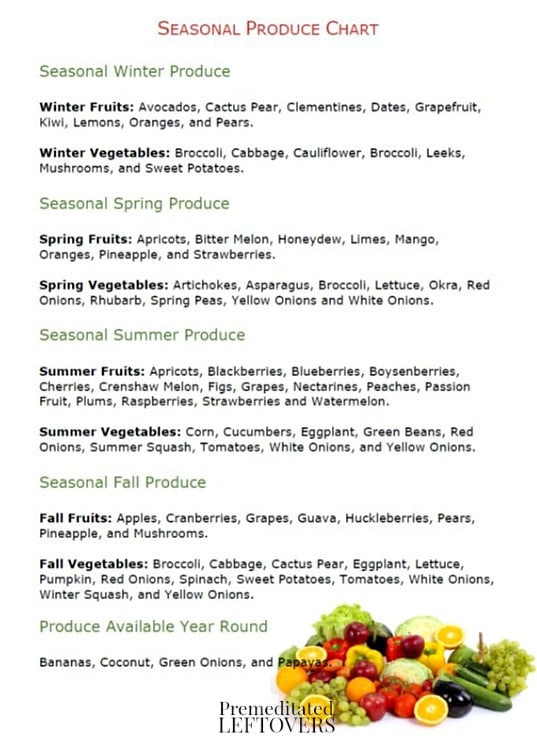This seasonal produce chart will help you save money by buying fruit and vegetables when they are most affordable.
One of the easiest ways to save on groceries is purchasing produce that is in season. When you go to the grocery store, you will typically find some produce that is in season and some that is not, making it hard to know what produce is in season.
You will often hear people telling you to only buy seasonal produce, but how do you know which items are in season? Most of us don’t have the time to Google every produce item while we are shopping. In fact, many of us are just trying to get in and out of the grocery store as quickly as possible.
When produce is out of season, it will be sold at a much higher price than it would be if it was in season. To help you easily identify which produce is in and out of season, I’ve created a produce guide for you.
Keep in mind that you can stock up on produce when it is in season, just like you can cereal, chips or other snacks. Tomatoes are less expensive during the summer and fall. If you find a great price on tomatoes, spend a weekend making spaghetti sauce for the next several months. This will ensure you don’t have to buy tomatoes during the months when they are priced higher. You can also freeze many fruits and vegetables as well as can fresh produce or dehydrate fruits and veggies for later.
Keep in mind that what in-season produce is on sale or available can vary slightly by your location and region. Check with your local grocery store produce manager if you have questions about what is in season in your area.
Seasonal Produce Chart:
A Guide to What Produce is in Season When
Seasonal Winter Produce
Fruits and vegetables that are in season during the winter months of December, January, and February.
Seasonal Winter Fruits:
- Avocados
- Cactus Pear
- Clementines
- Dates
- Grapefruit
- Kiwi
- Lemons
- Oranges
- Pear
Seasonal Winter Vegetables:
- Broccoli
- Cabbage
- Cauliflower
- Broccoli
- Leeks
- Mushrooms
- Sweet Potatoes
Seasonal Spring Produce
Fruits and vegetables that are in season during the spring months of March, April, and May.
Seasonal Spring Fruits:
- Apricots
- Bitter Melon
- Honeydew
- Limes
- Mango
- Oranges
- Pineapple
- Strawberries
Seasonal Spring Vegetables:
- Artichokes
- Asparagus
- Broccoli
- Lettuce
- Okra
- Red Onions
- Rhubarb
- Spring Peas
- Yellow Onions
- White Onions
- Zucchini
Seasonal Summer Produce
Fruits and vegetables that are in season during the summer months of June, July, and August.
Seasonal Summer Fruits:
- Apricots
- Blackberries
- Blueberries
- Boysenberries
- Cherries
- Crenshaw Melon
- Figs
- Grapes
- Nectarines
- Peaches
- Passion Fruit
- Plums
- Raspberries
- Strawberries
- Watermelon
Seasonal Summer Vegetables:
- Corn
- Cucumbers
- Green Beans
- Eggplant
- Red Onions
- Summer Squash
- Tomatoes
- White Onions
- Yellow Onions
Seasonal Fall Produce
Fruits and vegetables that are in season during the fall months of September, October, and November.
Seasonal Fall Fruits:
- Apples
- Cranberries
- Grapes
- Guava
- Huckleberries
- Pears
- Pineapple
- Mushrooms
Seasonal Fall Vegetables:
- Broccoli
- Cabbage
- Cactus Pear
- Eggplant
- Lettuce
- Pumpkin
- Red Onions
- Spinach
- Sweet Potatoes
- Tomatoes
- White Onions
- Winter Squash
- Yellow Onions
Produce Available Year-Round
There are a few things that are considered in-season year-round. Below is a list of fruits and vegetables that are in season year-round:
- Bananas
- Coconut
- Green Onions
- Papayas
Consult this list when making your menu plan to help you save money on groceries while eating fruits and vegetables at the peak of freshness. Bookmark this post to make it easy to find or print the seasonal produce chart below by clicking on the picture or clicking here.




Joanne T Ferguson says
G’day! I love cooking with locally produced foods, true!
And love the change of seasons re seasonal foods as always becomes a new fun challenge on what I can create and do; always what I can learn through others too!
Cheers! Joanne
http://www.facebook.com/whatsonthelist